Deck 7: Aggregate Demand and Aggregate Supply
سؤال
سؤال
سؤال
سؤال
سؤال
سؤال
سؤال
سؤال
سؤال
سؤال
سؤال
سؤال
سؤال

فتح الحزمة
قم بالتسجيل لفتح البطاقات في هذه المجموعة!
Unlock Deck
Unlock Deck
1/13
العب
ملء الشاشة (f)
Deck 7: Aggregate Demand and Aggregate Supply
1
Other things equal, what effect will each of the following have on the equilibrium price level and level of real output?
a.?An increase in aggregate demand in the steep portion of the aggregate supply curve.
a.?An increase in aggregate demand in the steep portion of the aggregate supply curve.
(a)It is given that initially the economy is in equilibrium. Other things remaining constant, an increase in aggregate demand will shift the aggregate demand curve to the right. It is given that the aggregate demand intersects in the steep portion of the aggregate supply curve. Thus the result is rise in price level and little change in real output. The graph is shown below: 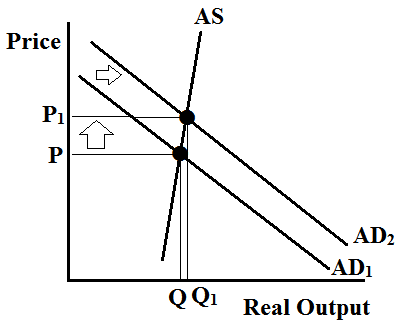 It is clearly seen from the graph that as the aggregate demand increases, the price level rises and the real output falls.
It is clearly seen from the graph that as the aggregate demand increases, the price level rises and the real output falls.
(b)It is given that there is no change in aggregate demand that means the demand curve remains the same. Now, an increase in aggregate supply will shift the aggregate supply curve to the right (downwards). The new equilibrium is achieved at the intersection of old aggregate demand curve and new aggregate supply curve. As a result, the price level falls down and real output increases. The graph is as follows: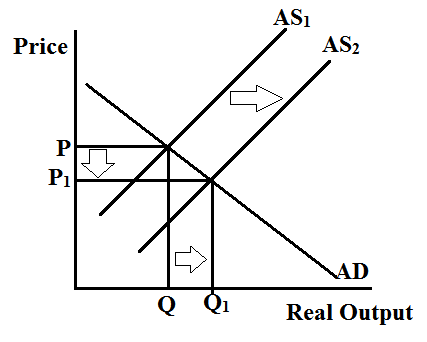 It is clearly seen from the graph that as the aggregate supply increases, the price level falls and the real output rises.
It is clearly seen from the graph that as the aggregate supply increases, the price level falls and the real output rises.
(c)Equal increase in aggregate demand and aggregate supply means that both the curves will shift to right and in the same proportion. The result is increase in real output and the price level remains the same. The graph is as follows: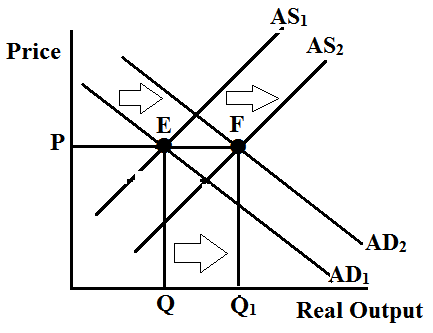 Initially the economy is in equilibrium at point E. After the increase in aggregate demand and supply, the new equilibrium is attained at point F. The price level remains the same but the real output increases.
Initially the economy is in equilibrium at point E. After the increase in aggregate demand and supply, the new equilibrium is attained at point F. The price level remains the same but the real output increases.
(d)It is given that initially the economy is in equilibrium. Other things remaining constant, a decrease in aggregate demand will shift the aggregate demand curve to the left. It is given that the aggregate demand intersects in the flat portion of the aggregate supply curve. Thus the result is little change in price level but decline in real output level. The graph is as follows: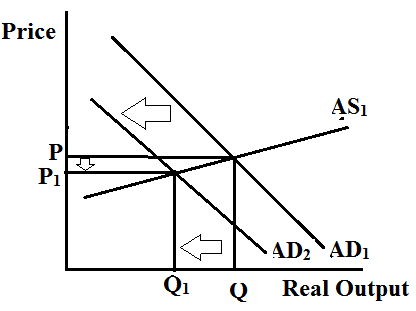 It is clearly seen from the graph that as the aggregate demand decreases, the price level falls and the real output falls.
It is clearly seen from the graph that as the aggregate demand decreases, the price level falls and the real output falls.
(e)Other things remaining constant, an increase in aggregate demand will shift the demand curve to the right and decrease in aggregate supply will shift the supply curve to the left (upward). The equilibrium is found where the new demand curve and new supply curve intersects. The result is increase in price but the change in real output is indeterminate.
 It is clearly seen from the graph that as the aggregate demand increases, the price level rises and the real output falls.
It is clearly seen from the graph that as the aggregate demand increases, the price level rises and the real output falls. (b)It is given that there is no change in aggregate demand that means the demand curve remains the same. Now, an increase in aggregate supply will shift the aggregate supply curve to the right (downwards). The new equilibrium is achieved at the intersection of old aggregate demand curve and new aggregate supply curve. As a result, the price level falls down and real output increases. The graph is as follows:
 It is clearly seen from the graph that as the aggregate supply increases, the price level falls and the real output rises.
It is clearly seen from the graph that as the aggregate supply increases, the price level falls and the real output rises. (c)Equal increase in aggregate demand and aggregate supply means that both the curves will shift to right and in the same proportion. The result is increase in real output and the price level remains the same. The graph is as follows:
 Initially the economy is in equilibrium at point E. After the increase in aggregate demand and supply, the new equilibrium is attained at point F. The price level remains the same but the real output increases.
Initially the economy is in equilibrium at point E. After the increase in aggregate demand and supply, the new equilibrium is attained at point F. The price level remains the same but the real output increases. (d)It is given that initially the economy is in equilibrium. Other things remaining constant, a decrease in aggregate demand will shift the aggregate demand curve to the left. It is given that the aggregate demand intersects in the flat portion of the aggregate supply curve. Thus the result is little change in price level but decline in real output level. The graph is as follows:
 It is clearly seen from the graph that as the aggregate demand decreases, the price level falls and the real output falls.
It is clearly seen from the graph that as the aggregate demand decreases, the price level falls and the real output falls. (e)Other things remaining constant, an increase in aggregate demand will shift the demand curve to the right and decrease in aggregate supply will shift the supply curve to the left (upward). The equilibrium is found where the new demand curve and new supply curve intersects. The result is increase in price but the change in real output is indeterminate.
2
Refer to the data in the table that accompanies Problem 2. Suppose that the present equilibrium price level and level of real GDP are 100 and $225, and that data set B represents the relevant aggregate supply schedule for the economy. LO4
a. What must be the current amount of real output demanded at the 100 price level?
b. If the amount of output demanded declined by $25 at the 100 price shown levels in B, what would be the new equilibrium real GDP? In business cycle terminology, what would economists call this change in real GDP?
a. What must be the current amount of real output demanded at the 100 price level?
b. If the amount of output demanded declined by $25 at the 100 price shown levels in B, what would be the new equilibrium real GDP? In business cycle terminology, what would economists call this change in real GDP?
Real Gross Domestic Production ( GDP ) refers to the total value of all final goods and services produced given a period of time or in a year.
The data table is reproduced below: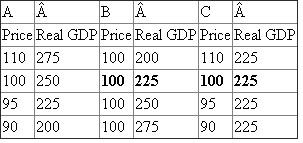 a. In column B, the output price stays the same, which means that this is the immediate-short run supply schedule. The amount of real output demanded at the 100 price level must equal to the amount supplied, which is $225.
a. In column B, the output price stays the same, which means that this is the immediate-short run supply schedule. The amount of real output demanded at the 100 price level must equal to the amount supplied, which is $225.
b. If the amount of output demanded falls by $25, the new demand is $200 and the supply will meet the current demand, which is $200. The new equilibrium price will be 100 and demand/supply level $200. The terminology used for this situation is recession.
The data table is reproduced below:
 a. In column B, the output price stays the same, which means that this is the immediate-short run supply schedule. The amount of real output demanded at the 100 price level must equal to the amount supplied, which is $225.
a. In column B, the output price stays the same, which means that this is the immediate-short run supply schedule. The amount of real output demanded at the 100 price level must equal to the amount supplied, which is $225.b. If the amount of output demanded falls by $25, the new demand is $200 and the supply will meet the current demand, which is $200. The new equilibrium price will be 100 and demand/supply level $200. The terminology used for this situation is recession.
3
Why does a reduction in aggregate demand in the actual economy reduce real output, rather than the price level? Why might a full-strength multiplier apply to a decrease in aggregate demand? LO3
In the actual economy, the price is inflexible downward because of menu cost, reduction of effort, price war, wage contract and minimum wage, thus the reduction of demand only reduces real output and does not affect short-run equilibrium price.
When price is rigid a decrease in demand causes real output to decrease by the same amount that the demand decreases. The multiplier effect is in full strength. When the price rises with the demand, the multiplier effect is absorbed partly by the increase in price, which leaves output increases by a less amount as the increase in the demand.
When price is rigid a decrease in demand causes real output to decrease by the same amount that the demand decreases. The multiplier effect is in full strength. When the price rises with the demand, the multiplier effect is absorbed partly by the increase in price, which leaves output increases by a less amount as the increase in the demand.
4
Explain: "Unemployment can be caused by a decrease of aggregate demand or a decrease of aggregate supply." In each case, specify the price-level outcomes. LO4

فتح الحزمة
افتح القفل للوصول البطاقات البالغ عددها 13 في هذه المجموعة.
فتح الحزمة
k this deck
5
In early 2001 investment spending sharply declined in the United States. In the 2 months following the September 11, 2001 attacks on the United States, consumption also declined. Use AD-AS analysis to show the two impacts on real GDP. LO4

فتح الحزمة
افتح القفل للوصول البطاقات البالغ عددها 13 في هذه المجموعة.
فتح الحزمة
k this deck
6
Explain how hyperinflation might lead to a severe decline in total output.

فتح الحزمة
افتح القفل للوصول البطاقات البالغ عددها 13 في هذه المجموعة.
فتح الحزمة
k this deck
7
Suppose that consumer spending initially rises by $5 billion for every 1 percent rise in household wealth and that investment spending initially rises by $20 billion for every 1 percentage point fall in the real interest rate. Also assume that the economy's multiplier is 4. If household wealth falls by 5 percent because of declining house values, and the real interest rate falls by two percentage points, in what direction and by how much will the aggregate demand curve initially shift at each price level? In what direction and by how much will it eventually shift? LO1

فتح الحزمة
افتح القفل للوصول البطاقات البالغ عددها 13 في هذه المجموعة.
فتح الحزمة
k this deck
8
What is the general relationship between a country's price level and the quantity of its domestic output (real GDP) demanded? Who are the buyers of U.S. real GDP?

فتح الحزمة
افتح القفل للوصول البطاقات البالغ عددها 13 في هذه المجموعة.
فتح الحزمة
k this deck
9
Answer the following questions on the basis of the three sets of data for the country of North Vaudeville: LO2
 a. Which set of data illustrates aggregate supply in the immediate short-run in North Vaudeville? The short run? The long run?
a. Which set of data illustrates aggregate supply in the immediate short-run in North Vaudeville? The short run? The long run?
b. Assuming no change in hours of work, if real output per hour of work increases by 10 percent, what will be the new levels of real GDP in the right column of A? Does the new data reflect an increase in aggregate supply or does it indicate a decrease in aggregate supply?
 a. Which set of data illustrates aggregate supply in the immediate short-run in North Vaudeville? The short run? The long run?
a. Which set of data illustrates aggregate supply in the immediate short-run in North Vaudeville? The short run? The long run?b. Assuming no change in hours of work, if real output per hour of work increases by 10 percent, what will be the new levels of real GDP in the right column of A? Does the new data reflect an increase in aggregate supply or does it indicate a decrease in aggregate supply?

فتح الحزمة
افتح القفل للوصول البطاقات البالغ عددها 13 في هذه المجموعة.
فتح الحزمة
k this deck
10
What assumptions cause the immediate-short-run aggregate supply curve to be horizontal? Why is the long-run aggregate supply curve vertical? Explain the shape of the short-run aggregate supply curve. Why is the short-run curve relatively flat to the left of the full-employment output and relatively steep to the right? LO2

فتح الحزمة
افتح القفل للوصول البطاقات البالغ عددها 13 في هذه المجموعة.
فتح الحزمة
k this deck
11
Suppose that the aggregate demand and aggregate supply schedules for a hypothetical economy are as shown below: LO3
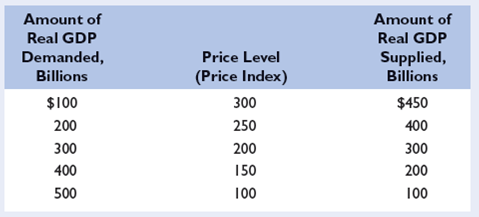 a. Use these sets of data to graph the aggregate demand and aggregate supply curves. What is the equilibrium price level and the equilibrium level of real output in this hypothetical economy? Is the equilibrium real output also necessarily the full-employment real output?
a. Use these sets of data to graph the aggregate demand and aggregate supply curves. What is the equilibrium price level and the equilibrium level of real output in this hypothetical economy? Is the equilibrium real output also necessarily the full-employment real output?
b. If the price level in this economy is 150, will quantity demanded equal, exceed, or fall short of quantity supplied? By what amount? If the price level is 250, will quantity demanded equal, exceed, or fall short of quantity supplied? By what amount?
c. Suppose that buyers desire to purchase $200 billion of extra real output at each price level. Sketch in the new aggregate demand curve as AD1. What is the new equilibrium price level and level of real output?
 a. Use these sets of data to graph the aggregate demand and aggregate supply curves. What is the equilibrium price level and the equilibrium level of real output in this hypothetical economy? Is the equilibrium real output also necessarily the full-employment real output?
a. Use these sets of data to graph the aggregate demand and aggregate supply curves. What is the equilibrium price level and the equilibrium level of real output in this hypothetical economy? Is the equilibrium real output also necessarily the full-employment real output?b. If the price level in this economy is 150, will quantity demanded equal, exceed, or fall short of quantity supplied? By what amount? If the price level is 250, will quantity demanded equal, exceed, or fall short of quantity supplied? By what amount?
c. Suppose that buyers desire to purchase $200 billion of extra real output at each price level. Sketch in the new aggregate demand curve as AD1. What is the new equilibrium price level and level of real output?

فتح الحزمة
افتح القفل للوصول البطاقات البالغ عددها 13 في هذه المجموعة.
فتح الحزمة
k this deck
12
Other things equal, what effects would each of the following have on aggregate demand oraggregate supply? In each case use a diagram to show the expected effects on the equilibrium price level and the level of real output.
a. A reduction in the economy's real interest rate.
a. A reduction in the economy's real interest rate.

فتح الحزمة
افتح القفل للوصول البطاقات البالغ عددها 13 في هذه المجموعة.
فتح الحزمة
k this deck
13
Suppose that the table below shows an economy's relationship between real output and the inputs needed to produce that output: LO3
 a. What is productivity in this economy?
a. What is productivity in this economy?
b. What is the per-unit cost of production if the price of each input unit is $2?
c. Assume that the input price increases from $2 to $3 with no accompanying change in productivity. What is the new per-unit cost of production? In what direction would the $1 increase in input price push the economy's aggregate supply curve? What effect would this shift of aggregate supply have on the price level and the level of real output?
d. Suppose that the increase in input price does not occur but, instead, that productivity increases by 100 percent. What would be the new per-unit cost of production? What effect would this change in per-unit production cost have on the economy's aggregate supply curve? What effect would this shift of aggregate supply have on the price level and the level of real output?
 a. What is productivity in this economy?
a. What is productivity in this economy?b. What is the per-unit cost of production if the price of each input unit is $2?
c. Assume that the input price increases from $2 to $3 with no accompanying change in productivity. What is the new per-unit cost of production? In what direction would the $1 increase in input price push the economy's aggregate supply curve? What effect would this shift of aggregate supply have on the price level and the level of real output?
d. Suppose that the increase in input price does not occur but, instead, that productivity increases by 100 percent. What would be the new per-unit cost of production? What effect would this change in per-unit production cost have on the economy's aggregate supply curve? What effect would this shift of aggregate supply have on the price level and the level of real output?

فتح الحزمة
افتح القفل للوصول البطاقات البالغ عددها 13 في هذه المجموعة.
فتح الحزمة
k this deck








